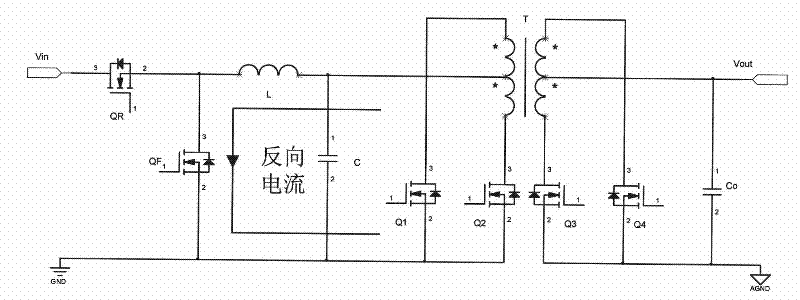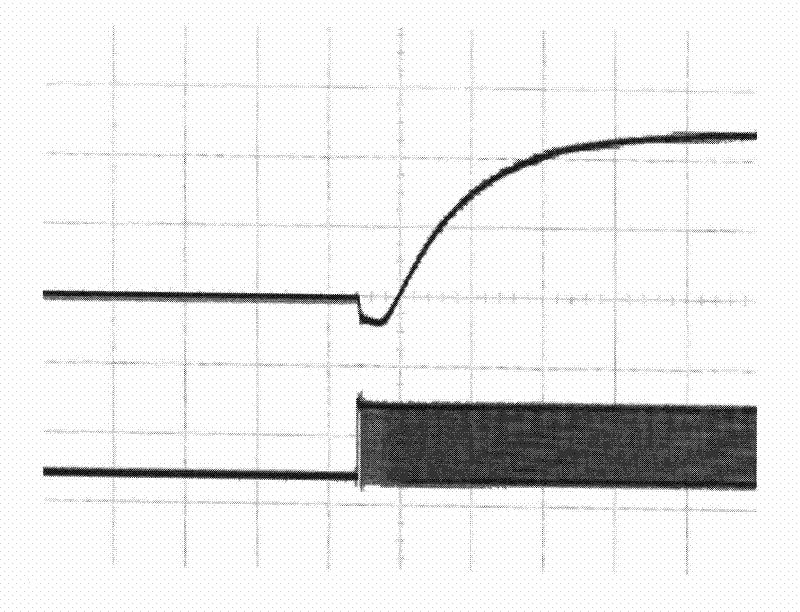Circuit used for drive control of flow current tube of direct current/direct current converter
A technology of DC converter and drive control, which is applied in the direction of converting DC power input to DC power output, control/regulation systems, instruments, etc. It can solve problems such as freewheeling tube and load damage, and achieve the elimination of reverse current and reverse current. The effect of directing current and stress and improving stability
- Summary
- Abstract
- Description
- Claims
- Application Information
AI Technical Summary
Problems solved by technology
Method used
Image
Examples
Embodiment 1
[0044] Such as Figure 7 As shown, a circuit for driving and controlling the freewheeling tube of the DC / DC converter.
[0045] Wherein, the charging and discharging network includes a first resistor R1 and a first capacitor C1, the reference voltage obtaining unit includes a second resistor R2 and a third resistor R3, the comparator includes an operational amplifier U and a fourth resistor R4, and the output control unit includes a field effect transistor Qc and the fifth resistor R5. The finishing tube pulse width modulation signal HD is connected to the first terminal of the first resistor R1, the second terminal of the first resistor R1 is connected to the first terminal of the first capacitor C1, and the inverting terminal of the operational amplifier U, respectively, and the second terminal of the first capacitor C1 is grounded , the first end of the second resistor R2 is connected to the first power supply, the second end is connected to the first end of the third resi...
Embodiment 2
[0064] Such as Figure 17 As shown, a circuit for driving and controlling the freewheeling tube of the DC / DC converter. The difference between this embodiment and the first embodiment lies in: the output control unit part and the comparator part.
[0065]In this embodiment, the charging and discharging network includes a first resistor R1 and a first capacitor C1, the reference voltage obtaining unit includes a second resistor R2 and a third resistor R3, the comparator includes an operational amplifier U and a fourth resistor R4, and the output control unit includes Field effect transistor Qc and fifth resistor R5. The pulse width modulation signal of the sorting tube is connected to the first terminal of the first resistor R1, the second terminal of the first resistor R1 is connected to the first terminal of the first capacitor C1, and the non-inverting terminal of the operational amplifier U, respectively, the second terminal of the first capacitor C1 is grounded, and the s...
Embodiment 3
[0068] Such as Figure 18 As shown, a circuit for driving and controlling the freewheeling tube of the DC / DC converter. The difference between this embodiment and the first embodiment lies in: the reference voltage obtaining unit part.
[0069] In this embodiment, the charging and discharging network includes a first resistor R1 and a first capacitor C1, the reference voltage obtaining unit includes a second resistor R2 and a voltage regulator tube Z, and the output control unit includes a field effect transistor Qc and a fifth resistor R5; the first Resistor R1 is connected to the pulse width modulation signal of the rectifier tube, the second terminal is connected to the first terminal of the first capacitor C1 and the inverting terminal of the operational amplifier respectively, the second terminal of the first capacitor C1 is grounded, and the first terminal of the second resistor R2 is connected to the first terminal of the second resistor R2. A power supply, the second ...
PUM
 Login to View More
Login to View More Abstract
Description
Claims
Application Information
 Login to View More
Login to View More - R&D
- Intellectual Property
- Life Sciences
- Materials
- Tech Scout
- Unparalleled Data Quality
- Higher Quality Content
- 60% Fewer Hallucinations
Browse by: Latest US Patents, China's latest patents, Technical Efficacy Thesaurus, Application Domain, Technology Topic, Popular Technical Reports.
© 2025 PatSnap. All rights reserved.Legal|Privacy policy|Modern Slavery Act Transparency Statement|Sitemap|About US| Contact US: help@patsnap.com



